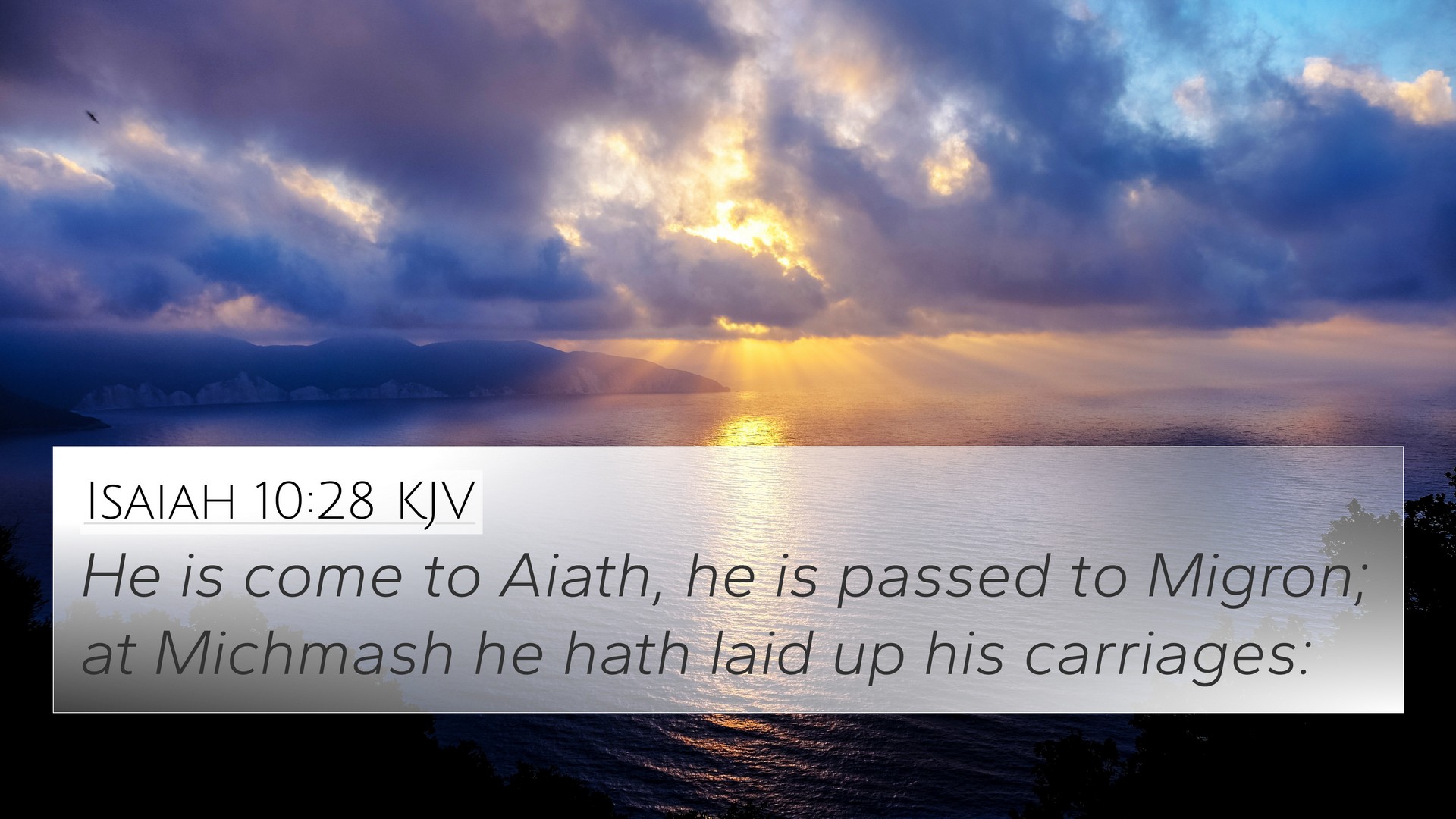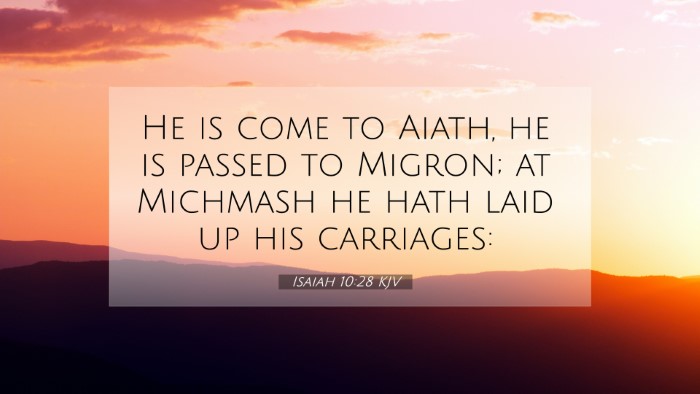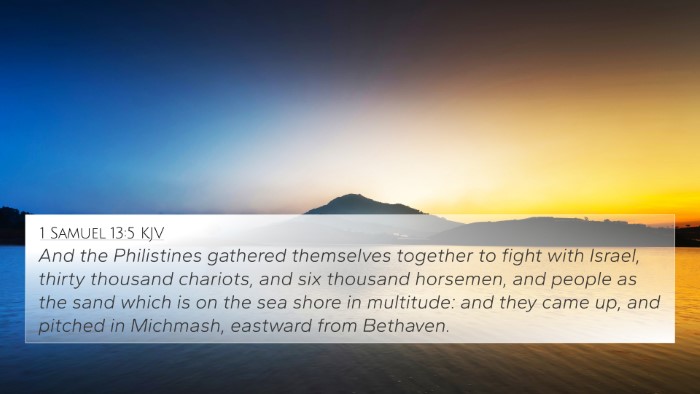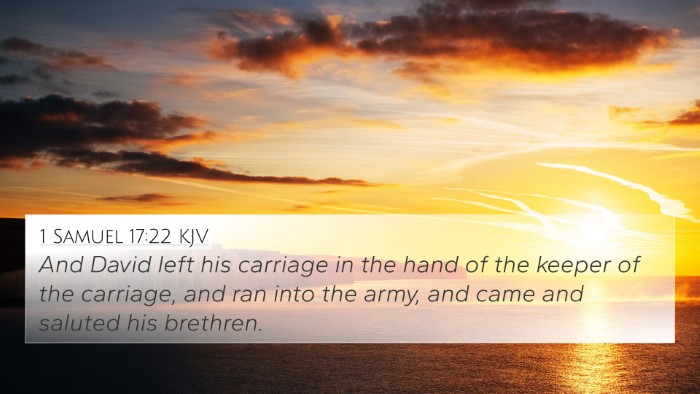Understanding Isaiah 10:28
Isaiah 10:28 states: "He has come to Aiath; he has passed through Migron; at Michmash he has stored his baggage." This verse serves as a geographical marker in the prophetic narrative, establishing a scene of impending doom related to the Assyrian invasion. By examining this verse through various public domain commentaries, we can gain deeper insights into its meaning and significance.
Commentary Summaries
Matthew Henry's Commentary
Matthew Henry highlights the imagery used in this passage. He interprets the mention of Aiath, Migron, and Michmash as representative of the Assyrian army’s progression through Israel, signifying their threat and the judgment of God. Henry emphasizes that the route taken by the Assyrians illustrates both their military strategy and God's overarching plan, showing how He uses nations to fulfill His purposes.
Albert Barnes' Notes on the Bible
Albert Barnes elaborates on the geographical significance of the locations mentioned. He notes that these places were part of the route used by the Assyrian forces and illustrates the advancing nature of the threat to Jerusalem. Barnes stresses that this prophetic notation serves as a prelude to the chaos that was to ensue, underscoring the seriousness of the Assyrian's intentions. He also reflects on the theme of divine judgment against Israel's unfaithfulness.
Adam Clarke's Commentary
Adam Clarke emphasizes the strategic locations named in the verse, providing context on their historical relevance. He suggests that these details serve to enhance the urgency of the prophecy. Clarke contemplates the significance of God allowing the Assyrians to move through these regions, presenting a call for repentance within Israel. His insights push readers to understand the connections of Israel's actions with the forthcoming judgment articulated by the prophet Isaiah.
Thematic Connections and Cross-References
Isaiah 10:28 stands as a contingent verse linking several themes found throughout the Bible. Below, we explore cross-references that enhance our understanding:
- 2 Kings 18:9-12 - Describes the Assyrian conquest and their attitude towards Israel, illustrating the theme of impending invasion.
- Isaiah 8:7-8 - Reflects on the impending floods of Assyrian forces and symbolizes a warning to Israel.
- Isaiah 14:24-27 - Provides context around God’s sovereignty over nations, asserting His control over Assyrian plans.
- Micah 5:5 - Offers a prophetic reminder of the coming ruler from Bethlehem who will be a shepherd to Israel amidst devastation.
- Jeremiah 46:20-22 - Compares the roles of nations in God's judgment, emphasizing Assyria's power as a tool for divine purposes.
- Psalm 46:1-2 - Affirms God as a refuge and strength, serving as a reminder for Israel amid its trials.
- Habakkuk 1:6 - Discusses God's commissioning of Babylon, analogous to Isaiah's portrayal of Assyria's might.
Insights on Cross-Referencing in the Bible
Understanding Isaiah 10:28 requires a close look at various connections between Bible verses, fostering a deeper comprehension of recurring themes. Cross-referencing can be an essential tool for Bible study and interpretation. The practice promotes the exploration of intertwined teachings across both the Old and New Testaments, enriching the reader’s insight into the character of God and His dealings with humanity.
Tools for Effective Bible Cross-Referencing
For anyone looking to deepen their study, several tools are invaluable:
- Bible Concordance - A systematic index aiding in the search for specific terms across biblical texts.
- Bible Cross-Reference Guide - Resource that connects verses with similar themes or teachings.
- Cross-Reference Bible Study Materials - Books or digital resources that categorize verses by thematic elements and relationships.
Conclusion
Isaiah 10:28 illustrates the complexities of God's plan through the lens of historical events, employing specific geographical markers to underscore the severity of Israel's predicament. By utilizing various commentaries and cross-referencing scripts, one can gain a profound understanding of both the prophetic warnings and the overarching themes central to the Christian faith.
As you continue your study, consider exploring the connections between other scriptures, observing how they enhance our understanding of God's relationship with His people. The links between the prophets and the apostolic teachings remain critical for grasping the continuity and depth of biblical doctrine.











